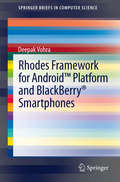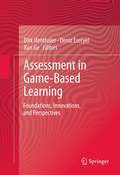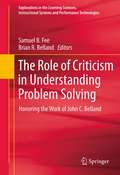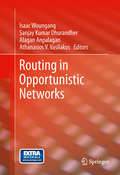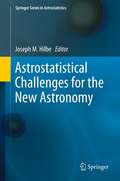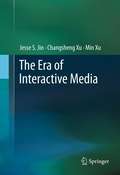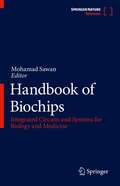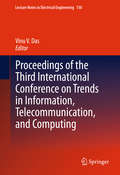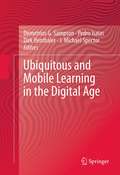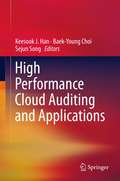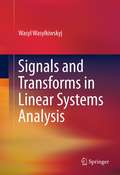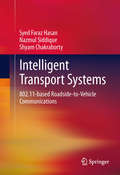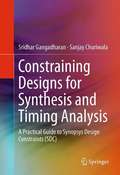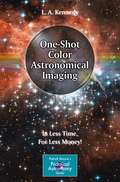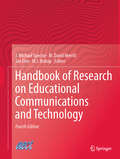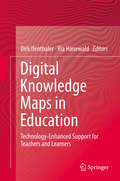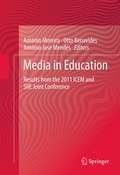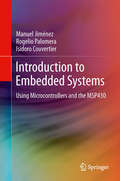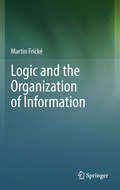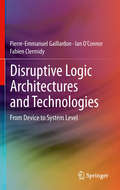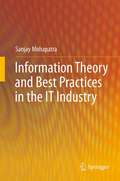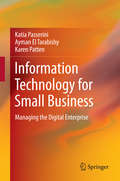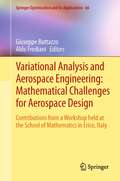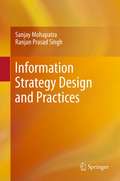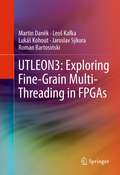- Table View
- List View
Rhodes Framework for Android™ Platform and BlackBerry® Smartphones
by Deepak VohraThe Rhodes framework offers several advantages over other mobile frameworks. Some of the unique features of the Rhodes frameworks are as follows: - The only smartphone framework to offer support for the Model View Controller pattern - The only smartphone framework to offer support for the Object-Relational manager -The only smartphone framework to offer offline, disconnected access to data with the Rho-Synch server - The only smartphone framework to support all mobile devices including Android, BlackBerry, iPhone, Symbian, and Windows - Provides Ruby implementations for all smartphone device operating systems -Provides a web-based Integrated Development Environment for developing mobile applications for all smartphone platforms with the RhoHub development service This book discusses developing Rhodes applications for Android and the BlackBerry platform, as these are the two most commonly used mobile platforms. For each, an application for creating a catalog and another application for getting RSS feed will be developed.
Assessment in Game-Based Learning: Foundations, Innovations, and Perspectives (Advances In Game-based Learning Ser.)
by Dirk Ifenthaler Xun Ge Deniz EseryelThe capabilities and possibilities of emerging game-based learning technologies bring about a new perspective of learning and instruction. This, in turn, necessitates alternative ways to assess the kinds of learning that is taking place in the virtual worlds or informal settings. accordingly, aligning learning and assessment is the core for creating a favorable and effective learning environment. The edited volume will cover the current state of research, methodology, assessment, and technology of game-based learning. There will be contributions from international distinguished researchers which will present innovative work in the areas of educational psychology, educational diagnostics, educational technology, and learning sciences. The edited volume will be divided into four major parts.
The Role of Criticism in Understanding Problem Solving
by Samuel Fee Brian BellandIn 1991, Denis Hlynka and John Belland released Paradigms Regained, a well received reader for graduate students in the field of educational technology. The Role of Criticism in Understanding Problem Solving updates some of those ideas initially proposed in Paradigms Regained, and extends the conversation into the contemporary discourse regarding problem based learning (PBL). Paradigms proposed the idea of criticism as a third method for the conduction of educational research, the first two being qualitative and qualitative. The concept of criticism as a tool for research is not well established in educational technology, although it is well established in other educational research traditions such as Curriculum Studies. Unfortunately, it is not always clear how criticism can be applied. This book views criticism as a way to step back and look at an educational intervention within educational technology through a particular critical lens. Criticism is viewed as a valuable approach to guiding meta analyses and theoretical studies, serving to prevent the proverbial "spinning of the wheels" that often happens in educational research. By indicating new potential research questions and directions, criticism approaches can invigorate educational research. This book revisits the ideals of criticism in order to establish their usefulness for studying educational technology interventions to support problem based learning. First, a few foundational chapters set the stage for the conversations on criticism. Then, the role criticism can play in enhancing analysis and interpretation of the PBL literature is explored. Finally, case studies addressing the central concepts of the text are presented and dissected. This book represents a complete overhaul and rethinking of the use of criticism as a method for understanding and furthering the research area of PBL within the field of Educational technology.
Routing in Opportunistic Networks
by Alagan Anpalagan Isaac Woungang Sanjay Kumar Dhurandher Athanasios V. VasilakosRouting in Opportunistic Networks focuses on the basics of opportunistic networks, modeling and communication in opportunistic networks, routing in opportunistic networks, and collaboration and cooperation in opportunistic networks. The editors will cover such topics as mobility characterization and discovery in opportunistic networks, scheduling and medium access control in opportunistic networks as well as testbed, tools, and measurements for opportunistic networks.
Astrostatistical Challenges for the New Astronomy (Springer Series in Astrostatistics #1)
by Joseph M. HilbeAstrostatistical Challenges for the New Astronomy presents a collection of monographs authored by several of the disciplines leading astrostatisticians, i.e. by researchers from the fields of statistics and astronomy-astrophysics, who work in the statistical analysis of astronomical and cosmological data. Eight of the ten monographs are enhancements of presentations given by the authors as invited or special topics in astrostatistics papers at the ISI World Statistics Congress (2011, Dublin, Ireland). The opening chapter, by the editor, was adapted from an invited seminar given at Los Alamos National Laboratory (2011) on the history and current state of the discipline; the second chapter by Thomas Loredo was adapted from his invited presentation at the Statistical Challenges in Modern Astronomy V conference (2011, Pennsylvania State University), presenting insights regarding frequentist and Bayesian methods of estimation in astrostatistical analysis. The remaining monographs are research papers discussing various topics in astrostatistics. The monographs provide the reader with an excellent overview of the current state astrostatistical research, and offer guidelines as to subjects of future research. Lead authors for each chapter respectively include Joseph M. Hilbe (Jet Propulsion Laboratory and Arizona State Univ); Thomas J. Loredo (Dept of Astronomy, Cornell Univ); Stefano Andreon (INAF-Osservatorio Astronomico di Brera, Italy); Martin Kunz ( Institute for Theoretical Physics, Univ of Geneva, Switz); Benjamin Wandel ( Institut d'Astrophysique de Paris, Univ Pierre et Marie Curie, France); Roberto Trotta (Astrophysics Group, Dept of Physics, Imperial College London, UK); Phillip Gregory (Dept of Astronomy, Univ of British Columbia, Canada); Marc Henrion (Dept of Mathematics, Imperial College, London, UK); Asis Kumar Chattopadhyay (Dept of Statistics, Univ of Calcutta, India); Marisa March (Astrophysics Group, Dept of Physics, Imperial College, London, UK).
The Era of Interactive Media
by Min Xu Jesse S. Jin Changsheng XuInteractive Media is a new research field and a landmark in multimedia development. The Era of Interactive Media is an edited volume contributed from world experts working in academia, research institutions and industry. The Era of Interactive Media focuses mainly on Interactive Media and its various applications. This book also covers multimedia analysis and retrieval; multimedia security rights and management; multimedia compression and optimization; multimedia communication and networking; and multimedia systems and applications. The Era of Interactive Media is designed for a professional audience composed of practitioners and researchers working in the field of multimedia. Advanced-level students in computer science and electrical engineering will also find this book useful as a secondary text or reference.
Handbook of Biochips: Integrated Circuits and Systems for Biology and Medicine
by Mohamad SawanThis book provides a broad survey of the field of biochips, including fundamentals of microelectronics and biomaterials interaction with various, living tissues, as well as numerous, diverse applications. Although a wide variety of biochips will be described, there will be a focus on those at the brain-machine interface. Analysis is included of the relationship between different categories of biochips and their interactions with the body and coverage includes wireless remote control of biochips and arrays of microelectrodes, based on new biomaterials.
Proceedings of the Third International Conference on Trends in Information, Telecommunication and Computing
by Vinu V. DasThird International Conference on Recent Trends in Information, Telecommunication and Computing - ITC 2012. ITC 2012 will be held during Aug 03-04, 2012, Kochi, India. ITC 2012, is to bring together innovative academics and industrial experts in the field of Computer Science, Information Technology, Computational Engineering, and Communication to a common forum. The primary goal of the conference is to promote research and developmental activities in Computer Science, Information Technology, Computational Engineering, and Communication. Another goal is to promote scientific information interchange between researchers, developers, engineers, students, and practitioners.
Ubiquitous and Mobile Learning in the Digital Age
by Dirk Ifenthaler J. Michael Spector Pedro Isaias Demetrios G. SampsonThis edited volume with selected expanded papers from CELDA (Cognition and Exploratory Learning in the Digital Age) 2011 (http://www.celda--conf.org/) will focus on Ubiquitous and Mobile Informal and Formal Learning in the Digital Age, with sub-topics: Mobile and Ubiquitous Informal and Formal Learning Environments (Part I), Social Web Technologies for new knowledge representation, retrieval, creation and sharing in Informal and Formal Educational Settings (Part II), Virtual Worlds and Game--based Informal and Formal Learning (Part III), Location--based and Context-- Aware Environments for Formal and Informal Learning Integration (Part IV) There will be approximately twenty chapters selected for this edited volume from among peer--reviewed papers presented at the CELDA (Cognition and Exploratory Learning in the Digital Age) 2011 Conference in Rio de Janeiro, Brazil in November, 2011.
High Performance Cloud Auditing and Applications
by Keesook J. Han Baek-Young Choi Sejun SongThis book mainly focuses on cloud security and high performance computing for cloud auditing. The book discusses emerging challenges and techniques developed for high performance semantic cloud auditing, and presents the state of the art in cloud auditing, computing and security techniques with focus on technical aspects and feasibility of auditing issues in federated cloud computing environments. In summer 2011, the United States Air Force Research Laboratory (AFRL) CyberBAT Cloud Security and Auditing Team initiated the exploration of the cloud security challenges and future cloud auditing research directions that are covered in this book. This work was supported by the United States government funds from the Air Force Office of Scientific Research (AFOSR), the AFOSR Summer Faculty Fellowship Program (SFFP), the Air Force Research Laboratory (AFRL) Visiting Faculty Research Program (VFRP), the National Science Foundation (NSF) and the National Institute of Health (NIH). All chapters were partially supported by the AFOSR Information Operations and Security Program extramural and intramural funds (AFOSR/RSL Program Manager: Dr. Robert Herklotz). Key Features: · Contains surveys of cyber threats and security issues in cloud computing and presents secure cloud architectures · Presents in-depth cloud auditing techniques, federated cloud security architectures, cloud access control models, and access assured information sharing technologies · Outlines a wide range of challenges and provides solutions to manage and control very large and complex data sets
Signals and Transforms in Linear Systems Analysis
by Wasyl WasylkiwskyjSignals and Transforms in Linear Systems Analysis covers the subject of signals and transforms, particularly in the context of linear systems theory. Chapter 2 provides the theoretical background for the remainder of the text. Chapter 3 treats Fourier series and integrals. Particular attention is paid to convergence properties at step discontinuities. This includes the Gibbs phenomenon and its amelioration via the Fejer summation techniques. Special topics include modulation and analytic signal representation, Fourier transforms and analytic function theory, time-frequency analysis and frequency dispersion. Fundamentals of linear system theory for LTI analogue systems, with a brief account of time-varying systems, are covered in Chapter 4 . Discrete systems are covered in Chapters 6 and 7. The Laplace transform treatment in Chapter 5 relies heavily on analytic function theory as does Chapter 8 on Z -transforms. The necessary background on complex variables is provided in Appendix A. This book is intended to serve as a text on signals and transforms for a first year one semester graduate course, primarily for electrical engineers.
Intelligent Transport Systems
by Nazmul Siddique Shyam Chakraborty Syed Faraz HasanFocusing on the nuts and bolts of wireless network access for computers on board vehicles, this volume shows how in-car computerization now does much more than merely act as a glorified map-reader. Wireless communication is transforming road travel in ways previously undreamt of, allowing vehicles to "talk" to a wider network and monitor road conditions, potential delays and traffic congestion, all automatically. Toll payments can be made without opening the driver's window on a cold day, while vehicles might themselves take active steps to avoid collisions. It is the connection between on-board computers and wireless access points, ubiquitous in most cities now, that is a key area of research. Moving vehicles transfer their communications to new points as they progress, and this causes delays, known as "handover latency". In this book, new stochastic models are developed to map the disruption when connecting to 802.11 WLAN points. It details the application of stochastic tools to analyzing communication networks, as well as previous literature on handover latency and relevant mathematical modeling. Finally, it presents a scheme for monitoring traffic congestion using WLAN connectivity. This volume will be a useful addition to the libraries both of wireless communication students and those studying probability theory.
Constraining Designs for Synthesis and Timing Analysis: A Practical Guide to Synopsys Design Constraints (SDC)
by Sanjay Churiwala Sridhar GangadharanThis book serves as a hands-on guide to timing constraints in integrated circuit design. Readers will learn to maximize performance of their IC designs, by specifying timing requirements correctly. Coverage includes key aspects of the design flow impacted by timing constraints, including synthesis, static timing analysis and placement and routing. Concepts needed for specifying timing requirements are explained in detail and then applied to specific stages in the design flow, all within the context of Synopsys Design Constraints (SDC), the industry-leading format for specifying constraints.
One-Shot Color Astronomical Imaging
by L. A. KennedyThis book shows amateur astronomers how to use one-shot CCD cameras, and how to get the best out of equipment that exposes all three color images at once. Because this book is specifically devoted to one-shot imaging, "One-Shot Color Astronomical Imaging" begins by looking at all the basics - what equipment will be needed, how color imaging is done, and most importantly, what specific steps need to be followed after the one-shot color images are taken. What is one-shot color imaging? Typically, astronomical cooled-chip CCD cameras record only one color at a time - rather like old-fashioned black & white cameras fitted with color filters. Three images are taken in sequence - in red, blue, and green light - and these are then merged by software in a PC to form a color image. Each of the three images must be taken separately through a suitable color filter, which means that the total exposure time for every object is more than tripled. When exposure times can run into tens of minutes or even hours for each of the three colors, this can be a major drawback for the time-pressed amateur. "One-Shot Color Astronomical Imaging" describes the most cost-effective and time-efficient way for any amateur astronomer to begin to photograph the deep-sky.
Handbook of Research on Educational Communications and Technology
by J. Michael Spector Jan Elen M. David Merrill M. J. BishopThe 4th edition of the Handbook of Research on Educational Communications and Technology expands upon the previous 3 versions, providing a comprehensive update on research pertaining to new and emerging educational technologies. Chapters that are no longer pertinent have been eliminated in this edition, with most chapters being completely rewritten, expanded, and updated Additionally, new chapters pertaining to research methodologies in educational technology have been added due to expressed reader interest. Each chapter now contains an extensive literature review, documenting and explaining the most recent, outstanding research, including major findings and methodologies employed. The Handbook authors continue to be international leaders in their respective fields; the list is cross disciplinary by design and great effort was taken to invite authors outside of the traditional instructional design and technology community.
Digital Knowledge Maps in Education
by Dirk Ifenthaler Ria HanewaldDigital knowledge maps are 'at a glance' visual representations that enable enriching, imaginative and transformative ways for teaching and learning, with the potential to enhance positive educational outcomes. The use of such maps has generated much attention and interest among tertiary education practitioners and researchers over the last few years as higher education institutions around the world begin to invest heavily into new technologies designed to provide online spaces within which to build resources and conduct activities. The key elements of this edited volume will comprise original and innovative contributions to existing scholarship in this field, with examples of pedagogical possibilities as they are currently practiced across a range of contexts. It will contain chapters that address, theory, research and practical issues related to the use of digital knowledge maps in all aspects of tertiary education and draws predominantly on international perspectives with a diverse group of invited contributors. Reports on empirical studies as well as theoretical/conceptual chapters that engage deeply with pertinent questions and issues raised from a pedagogical, social, cultural, philosophical, and/or ethical standpoint are included. Systematic literature reviews dealing with digital knowledge mapping in education are also an integral part of the volume.
Media in Education
by Antonio Jose Mendes António Moreira Otto BenavidesWith the aim of discussing "old" and "new" teaching technologies, based on research and on the strategies and praxis of the use of technologies and methodologies in the different teaching levels, and also embracing the contribution and active participation of researchers, teachers, creators, managers and other specialists, the work will provide inputs on the following topics: Students' perspectives on media in the classroom, Students and media (as content and as tools for learning), Educational Media Design, Institutional Impact of the integration of Educational Media, Old v. New Media: what really matters, Research and Evaluation, Personal and/or social learning environments/networks, Media and inclusion, Media and informal learning, Immersive learning environments, Virtual mobility in Education, Mobile learning, Media and literacies
Introduction to Embedded Systems
by Manuel Jiménez Rogelio Palomera Isidoro CouvertierThis textbook serves as an introduction to the subject of embedded systems design, using microcontrollers as core components It develops concepts from the ground up, covering the development of embedded systems technology, architectural and organizational aspects of controllers and systems, processor models, and peripheral devices. Since microprocessor-based embedded systems tightly blend hardware and software components in a single application, the book also introduces the subjects of data representation formats, data operations, and programming styles. The practical component of the book is tailored around the architecture of a widely used Texas Instrument's microcontroller, the MSP430 and a companion web site offers for download an experimenter's kit and lab manual, along with Powerpoint slides and solutions for instructors.
Logic and the Organization of Information
by Martin FrickéLogic and the Organization of Information closely examines the historical and contemporary methodologies used to catalogue information objects--books, ebooks, journals, articles, web pages, images, emails, podcasts and more--in the digital era. This book provides an in-depth technical background for digital librarianship, and covers a broad range of theoretical and practical topics including: classification theory, topic annotation, automatic clustering, generalized synonymy and concept indexing, distributed libraries, semantic web ontologies and Simple Knowledge Organization System (SKOS). It also analyzes the challenges facing today's information architects, and outlines a series of techniques for overcoming them. Logic and the Organization of Information is intended for practitioners and professionals working at a design level as a reference book for digital librarianship. Advanced-level students, researchers and academics studying information science, library science, digital libraries and computer science will also find this book invaluable.
Disruptive Logic Architectures and Technologies
by Fabien Clermidy Pierre-Emmanuel Gaillardon Ian O’connorThis book discusses the opportunities offered by disruptive technologies to overcome the economical and physical limits currently faced by the electronics industry. It provides a new methodology for the fast evaluation of an emerging technology from an architectural prospective and discusses the implications from simple circuits to complex architectures. Several technologies are discussed, ranging from 3-D integration of devices (Phase Change Memories, Monolithic 3-D, Vertical NanoWires-based transistors) to dense 2-D arrangements (Double-Gate Carbon Nanotubes, Sublithographic Nanowires, Lithographic Crossbar arrangements). Novel architectural organizations, as well as the associated tools, are presented in order to explore this freshly opened design space.
Information Theory and Best Practices in the IT Industry
by Sanjay MohapatraThe importance of benchmarking in the service sector is well recognized as it helps in continuous improvement in products and work processes. Through benchmarking, companies have strived to implement best practices in order to remain competitive in the product- market in which they operate. However studies on benchmarking, particularly in the software development sector, have neglected using multiple variables and therefore have not been as comprehensive. Information Theory and Best Practices in the IT Industry fills this void by examining benchmarking in the business of software development and studying how it is affected by development process, application type, hardware platforms used, and many other variables. Information Theory and Best Practices in the IT Industry begins by examining practices of benchmarking productivity and critically appraises them. Next the book identifies different variables which affect productivity and variables that affect quality, developing useful equations that explaining their relationships. Finally these equations and findings are applied to case studies. Utilizing this book, practitioners can decide about what emphasis they should attach to different variables in their own companies, while seeking to optimize productivity and defect density.
Information Technology for Small Business
by Ayman El Tarabishy Karen Patten Katia PasseriniInformation Technology for Small Business: Managing the Digital Enterprise provides an overview of how small and medium business enterprises (SMEs) can use flexibility, agility, and anticipation strategies to better utilize information technology and knowledge management. Because small and medium businesses tend to be late technology adopters, they could miss versatile and strategic workforce advantages that enable them to achieve higher efficiency and effectiveness through technology. This book shows these SMEs new technology trends that can transform the nature of their operations both in an evolutionary business path and through revolutionary opportunities. Information Technology for Small Business: Managing the Digital Enterprise applied correctly to small and medium business can be used as a strategic tool to reach growth and profit goals for the SMEs competing in a very dynamic and global marketplace. Examples include: identifying ways that IT can be used to develop strong relationships with customers and suppliers, and how to select the best technologies for business needs. Information Technology for Small Business: Managing the Digital Enterprise targets SME owners, educators, and practitioners working in the related fields of management, IT, IS, and CS-related disciplines. Advanced-level students and policy makers focusing on SMEs will also find this book valuable in terms of main concepts for discussion.
Variational Analysis and Aerospace Engineering: Mathematical Challenges for Aerospace Design
by Giuseppe Buttazzo Aldo FredianiThis volume consists of papers presented at the Variational Analysis and Aerospace Engineering Workshop II held in Erice, Italy in September 2010 at the International School of Mathematics "Guido Stampacchia". The workshop provided a platform for aerospace engineers and mathematicians (from universities, research centers and industry) to discuss the advanced problems requiring an extensive application of mathematics. The presentations were dedicated to the most advanced subjects in engineering and, in particular to computational fluid dynamics methods, introduction of new materials, optimization in aerodynamics, structural optimization, space missions, flight mechanics, control theory and optimization, variational methods and applications, etc. This book will capture the interest of researchers from both academia and industry.
Information Strategy Design and Practices
by Ranjan Prasad Singh Sanjay MohapatraInformation Strategy Design and Practices develops a framework for designing information technology strategy for an organization. Beyond this, it establishes an approach to not only implement it, but sustain it. The framework explains how IT strategy should have an alignment to business to reap the benefits of business. The book contains five case studies in different domains: retail, real estate development, IT product development, development sector, and education sector. These case studies have been applied to different countries, providing a global prospective to this emerging trend.
UTLEON3: Exploring Fine-Grain Multi-Threading in FPGAs
by Martin Daněk Lukáš Kohout Jaroslav Sýkora Roman Bartosiński Leoš KafkaThis book describes a specification, microarchitecture, VHDL implementation and evaluation of a SPARC v8 CPU with fine-grain multi-threading, called micro-threading. The CPU, named UTLEON3, is an alternative platform for exploring CPU multi-threading that is compatible with the industry-standard GRLIB package. The processor microarchitecture was designed to map in an efficient way the data-flow scheme on a classical von Neumann pipelined processing used in common processors, while retaining full binary compatibility with existing legacy programs.
